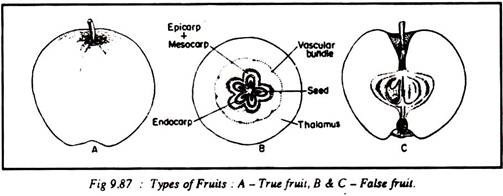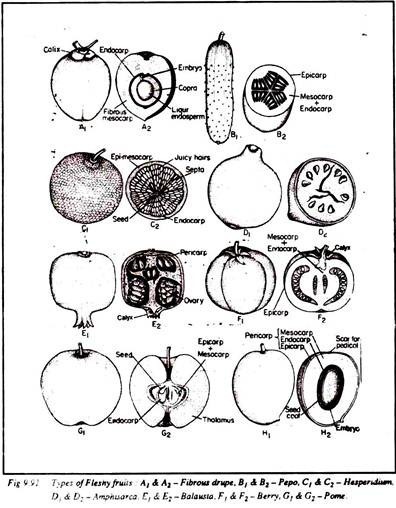The below mentioned article provides a study note on the Fruits of Angiospermic Plants.
Meaning of Fruit:
The fruit is the seed-bearing structure of angiospermic plants developed after fertilisation by ripening of the ovary.
Basically, two forms of fruits are essential to be recognised:
1. True fruit:
Fruit developed from the ovary and its inner structures only, i.e. no part other than the ovary has taken a share in its development, e.g. fruits of Mangifera indica (Fig 9.87-A), Brassica nigra etc.
2. False fruit or Pseudocarp:
Fruit developed from the ovary together with some other organs that develop along with it for its protection or nourishment or dispersal, e.g. Malus sylvestris (Fig 9.87-B & C), Shorea robusta, Cucumis sativa, etc.
Fruits are generally classified in a different manner and basically three groups have been made.
The following artificial key is useful to understand these groups:
A. One flower is responsible for fruit production. B. Only one fruit is produced from a flower…
(1) Simple Fruit
BB. Two or more fruits are produced from a flower
(2) Aggregate Fruit
AA.Many flowers (actually the entire inflorescence) are responsible in producing a single fruit
(3) Multiple Fruit.
1. Simple Fruits:
Simple fruits may be – A. Dry Fruits and B. Fleshy Fruits.
A. Dry Fruits:
Dry fruits, in turn may be:
I. Dehiscent fruits or
II. Indehiscent fruits.
I. Dehiscent Fruits:
In these fruits, pericarp either dehisces to release seeds or breaks into smaller pieces containing one or more seeds.
Following types of dehiscent fruits are generally seen:
i) Legume or Ped:
Develops from the superior monocarpellary ovary; splits along both the sutures, generally with a sudden jerk to disperse its seeds; seeds develop on a marginal placenta, e.g. Clitoria ternatea (Fig 9.88-A), Pisum sativum, Entada gigas, Bauhinia acuminate, etc. (all Leguminosae).
ii) Follicle:
Derived from a single carpel and splits open along one suture only, e.g. Calotropis gigantea (Fig 9.88-B), Delphinium ajacis, Sterculia foetida, etc. (Follicle as a true simple fruit is difficult to get; in Calotropis there is a pair of follicles; in Dephinium there are a few and in Sterculia, the polycarpcllary ovary splits into monocarpcllary segments which behave as follicles.)
iii) Siliqua:
Develops from a bicarpellary, one-chambered ovary which become 2-chambered, in course of development, with the formation of a false partition wall, called ‘replum’ and are generally much longer than broad. During dehiscence, the fruit wall opens gradually upwards from two sides but the replum persists on the stalk, e.g. Brassica nigra (Fig 9.88-C), Brassica oleracea, and many other members of Cruciferae.
iv) Capsule:
Developed from superior or inferior syncarpous ovaries with 2°C chambers (or become one chambered due to suppression of septa) which splits open to release its seeds.
According to their mode of splitting, capsules are of five types:
(a) Septicidal:
Septa splits longitudinally and from the axis to release its seeds, e.g. Aristolochia indica (Fig 9.88-E), Linum ussitatissimum, Digitalis purpurea, etc.
(b) Septifragal:
Septa breaks from the fruit wall and at the same time pericarp also breaks through the dorsal sutures of its individual carpel, but the axis remains intact, to release seeds, e.g. Datura metel (Fig 9.88-1), Bruganantia suaveolens, (= D. suaveolens), etc.
(c) Leculicidal:
Septa breaks from the axis and at the same time pericarp also breaks through the dorsal sutures of its individual carpels to release seeds, e.g. Althea rosea, Abolmoscus indica (Fig 9.88-F) Andrographis paniculata, Iris decora, etc.
(d) Porous Capsule:
Opens by apical pores, a separate pore for each of its chambers; in Campanula pyrinacea pores develop (Fig 9.88-H) at the tip of the fruit.
(e) Circumscissile Capsule or Pyxi dium or Pyxis:
Fruits one-chambered with seeds on free-central, free-basal or basal placentation and open all-round by a transverse split, e.g. Celosia cristata, Fig 9.88- G), Gomphrena globosa, Anagallis arvensis, etc.
vi) Schizocarp:
These fruits do not release seeds directly but break into smaller ones or few seeded parts (may be considered intermediate between dehiscent and indehiscent fruits) and are of many types:
(a) Lomentum:
Developed from monocarpellary superior ovary (like legumes) enclosing two or more seeds on the ventral suture ; become transversely constricted after each seed and finally breaks along these constrictions, Desmodium gangeticum (Fig 9.89-A), D. sequex, Alysicarpus vaginalis (Fig 9.89- A).
(b) Cremocarp:
Bicarpellary, bilocular capsules derived from inferior ovaries which split up into two indehiscent one-seeded parts (called mericarps) and remain attached at the tip of a common axis, the carpophore, e.g. Coriandrum sativum (Fig 9.89-B1 & B2) and other members of Umbelliferae.
(c) Carcerule:
Develops from an ovary with gynobasic style which becomes so deeply 4-lobed that, on maturity, it breaks longitudinaly into four 1-seeded nutlets, e.g. Ocimum sanctum (Fig 9.89-C) and other members of Labiatae.
(d) Regma:
Develops from a polycarpellery pistil and breaks up into as many component parts as the number of carpels, each part now called a coccus (pi. Cocci), Ricinus communis (Fig 9.89-D), Geranium nepalensis, and many other members of Euphorbiaceae, Geraniaceae, etc.
II. Indehiscent Fruits:
Here the pericarp is dry but it does not split to release seeds:
i) Achene:
Small, one-seeded fruit developed from a superior monocarpellary ovary where pericarp and testa remain free from each-other, e.g. Nelumbo nucifera (Fig 9.90-B1 & B2), etc.
ii) Caryopsis:
Like achene but the pericarp and seed-coat remain fused together and are inseparable, e.g. Zea mays (Fig 9.90-C) and other members of Gramineae.
iii) Cypsela:
Develops from a reduced bicarpellary, one-chambered, inferior ovary with solitary basal ovule where pericarp and seed-coat remain free from one another, e.g. Helianthus annus (Fig 9.90-D) and other members of Compositae.
iv) Nut:
Like achene, single seeded, but developed from bi- or multilocular superior ovary where the pericarp is tough or woody, e.g. Anacardium occidental (Fig 9.90-E), Quercus pachyphylla, Nephalium litchi, etc.
v) Samara:
Does not split open to release seeds and one or more portions of pistil are extended to form flattened wings, e.g. Ventillago maderaspatana (Fig 9.90-F), Fraxinus floribunda, Hiptage madhabilata etc.
The samara of Acer sp., provided with two wings, however breaks into 2-cocci on maturity.
vi) Samaroid:
Basically nut but provided with wings which are produced from the accessory whorl of the flower, e.g. Shorea robusta (Fig 9.90-A), wings are persistent sepals etc.
B. Fleshy Fruits:
The fleshy fruits are characterised by a soft and fleshy pericarp when ripe.
Here, the pericarp is generally well-differentiated into three parts:
1. Epicarp or exocarp (outer wall, which is generally leathery),
2. Mesocarp (middle portion, which is generally fleshy) and
3. Endocarp (inner wall, which may be fleshy or leathery or membranous or stony). Usually, the fleshy fruits are indehiscent.
The following types are common:
i) Drupe:
Generally one-seeded fruit with skinny or leathery epicarp, fleshy mesocarp and stony endocarp (surrounding the seed) and the seed-coat becomes very thin, e.g. Mangifera indica (Fig 9.91-H1 & H2), Zizyphus mauritiana, Prunus cerasus, Juglans regia, etc.
The fruits of Palmae are generally considered as fibrous drupes, as the mesocarp is fibrous (e.g. Cocos nucifera, Fig 9.91-A1 & A2). The fruits of Borassus flabellifer are three-seeded, each of which is surrounded by separate stony endocarp.
ii) Berry or Bacca:
It usually refers to any fleshy fruit which has no hard part except the seed-coat.
There are many types of baccate fruits:
(a) Pepo:
Develops from 1-chambered, syncarpous, inferior ovary with parietal placenta (sometimes falsely appear 3 or more chambered due to the proliferation of placental tissue); e.g. Cucumis sativa (Fig 9.91-B1 & B2) and many other members of Cucurbitaceae.
(b) Hesperidium:
Develops from superior, many-chambered syncarpous ovary with axile placentation where the endocarp projects inward forming separable chambers in which some unicellular juicy hairs develop from the endocarp; epi- and mesocarps unite to form a skin or rind; e.g. Citrus aurantium (Fig 9.91-C1 & C2) and the fruits of other species of this genus.
(c) Amphisarca:
It develops from superior, many chambered, syncarpous ovary with axile placentation. Epicarp and some portion of mesocarp become stony. The remaining portion of pericarp along with the placental tissues forms a soft and pulpy mass and the testa is mucilaginous, e.g. Aegle marmelos (Fig 9.91-D1 & D2), Feronia elephantum, etc.
(d) Balausta:
It develops from syncarpous, inferior ovary with carpels arranged in two parallel tiers. Pericarp becomes leathery and the testa becomes juicy, e.g. Punica granatum (Fig 9.91-E1 & E2).
(e) Pome:
Also develop from inferior syncarpous ovary where the actual fruit remains surrounded by fleshy thalamus, e.g. Malus sylvestris (= Pyrus malus), (Fig 9.91-G] & G2), Pyrus communis, etc.
(f) Berry-proper:
This develops from superior syncarpous ovary with axile and much proliferated placenta, epicarp is thin and skinny; mesocarp and endocarp are inseparable, soft and pulpy, e.g. Lycopersicum esculentum Fig 9.91-F1 & F2), Solanum melongena, Physalis peruviana, etc.
2. Aggregate Fruits:
If more than one fruit are produced from a single flower then they are referred to as aggregate fruits. Those fruits or fruitlets generally form a bunch or ‘etaerio’ or fruitlets.
The following types are generally found:
i) Etaerio of follicles:
A bunch of follicles develop from the apocarpous pistil, e.g. Michelia champaca (Fig 9.92-A), Magnolia campbellii’, etc.
The pair of follicles as found in Apocynaceae and Asclcpiadaceae is developed from the free ovaries of a bicarpellary pistil where the styles and stigmas remain united, e.g. Catharanthus roseus (Fig 9.92-B), Pargularia daemia, etc.
ii) Etaerio of Achenes:
A bunch of achenes develop from the apocarpous pistil, e.g. Naravelia zeylanica (Fig 9.91-C1 & C2), Clematis montana, Fragaria rubiginosa, etc.
iii) Etaerio of Berries:
A bunch of berries developed from apocarpous pistil, e.g. Artabotrys odoratissima (Fig 9.92-D1 & D2), Polyalthia longifolia etc.
iv) Etaerie of drupes:
A bunch of drupes develop from an apocarpous pistil, e.g. Rubus ellipticus (Fig 9.92-E1 & E2) of this genus.
v) Hep:
Here the fruitlets are actually achenes but remain packed within fleshy hypanthium, e.g. Rosa sericea (Fig 9.92-F1 & F2).
3. Multiple Fruits:
All the flowers of an inflorescence together leads to the development of a multiple or composite fruit.
They are mainly of two types:
i) Sorosis:
Flowers grown around a thick central rachis produce a sorosis type of fruit. Not only the fruits, but also the bracts, perianth members, etc. become fleshy and juicy and form parts of such compound fruits. However, the area occupied by individual simple fruits can be recognised on the fruit-surface by careful observation, e.g. Artocarpus heterophylla Fig 9.93-A1 & A2), Ananas sativus (Fig 9.93-C), Morus australis, etc.
Another term, Coenocarpium, is sometimes used for the fruits where bracts and perianth have great role in its formation, e.g. Ananas sativus.
ii) Syconus:
When the flowers in hypanthodium and coenanthium infloresence produce fruits, the entire structure, now, will be considered as a syconus type of multiple fruit, e.g. Ficus benghalensis (Fig 9.93-B1 & B2), and all other species under this genus, Lecanthus peduncularis (Fig 9.93-D1 & D2), Elatostemma sessilis, etc.






